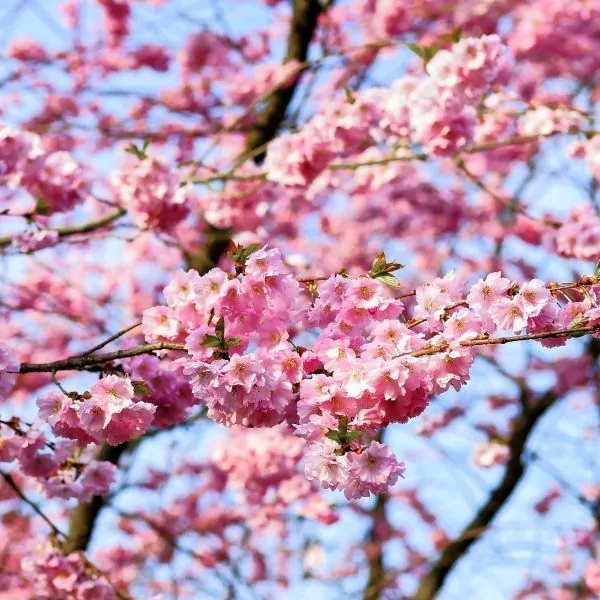In the tapestry of nature, sometimes a species stands out for its innate beauty and time-defying behavior—enter the Autumn Blooming Cherry, Prunus subhirtella ‘Autumnalis.’ For garden enthusiasts, the allure of this particular tree extends beyond the typical spring bloomers, challenging the traditional notions of nature’s calendar. This article is set to unfold the poetic charm and practical wisdom of cultivating the Autumn Blooming Cherry, offering valuable insights for those who seek to enrich their gardens with this unique specimen.
Unveiling the Beauty and Benefits
Prunus subhirtella ‘Autumnalis’ is a testament to nature’s artistry. While most cherries grace us with their blossoms in the fleeting embrace of spring, the Autumn Blooming Cherry dares to be different. It begins flowering in late fall, leaves still ablaze with the remnants of autumnal colors or, in milder climates, stepping shyly into the chilly winter season.
Its delicate pink-white flowers, contrasting against the barren branches of its contemporaries, present a mesmerizing sight, especially in the subdued light of autumn and winter. The appeal isn’t merely aesthetic; for those who heartily welcome the softer side of winter, this early-blooming cherry provides an emotional lift that only nature, in its resilient joy, can.
Beyond the optics, the Autumn Blooming Cherry is a haven for wildlife. Bees and other pollinators are in short supply during these cooler months, yet the Autumnalis steps in as a generous host, offering nourishment to those in need. As the harbinger of life in seemingly dormant periods, few trees can polka-dot the garden with as much life as the Autumn Blooming Cherry.
Planting and Nurturing Your Autumnalis
Planting a Prunus subhirtella ‘Autumnalis’ involves a marriage of craftsmanship and care. The ideal conditions for this tree are a spot in the garden that receives full sunlight, although it can tolerate partial shade. When it comes to soil, well-draining and slightly acidic are the watchwords. Regular watering, especially during dry or winter months, is critical to establishing a robust root system.
When planting, create a hole just as deep and twice as wide as the root ball, gently spreading the roots to encourage outward growth. Tamping down the soil firmly, but not compacting, is essential to reduce air pockets that can damage tender young roots.
As your Autumn Blooming Cherry tree matures, light pruning after the flowering season (and after the risk of frost has passed) will help shape its growth and encourage a bountiful display year after year. Avoid heavy pruning, which can compromise the following year’s blossoms.
Landscaping with the Autumnalis
The Autumn Blooming Cherry can play various roles in the mosaic of your garden design. As a standalone feature in a more minimalist landscape, its unique blooming pattern will draw the eye and warm the spirit on the grayest days. Paired with evergreens or other plants that offer structure, it forms the centerpiece of a winter garden that’s anything but dreary.
For a more naturalistic area, allow it to mingle with shrubs and ground covers, creating a dynamic living canvas that shifts and pleases with the changing seasons. Bird feeders and baths strategically placed near the tree will invite wildlife to your domain, complementing the fertility of the cherry blossoms.
Cultivating Autumnalis: Varieties and Unique Traits
Beyond the species Prunus subhirtella ‘Autumnalis,’ there are cultivars within the Autumn Blooming Cherry family that offer subtle variations in form and function. ‘Jugatsu-sakura,’ for instance, flaunts double flowers, further enhancing its beauty and appeal to the effervescent garden connoisseur.
While the differences may seem subtle, choosing the suitable cultivar can fine-tune your garden’s vision through season extension, maximizing spatial constraints, or achieving a singular aesthetic.
The Unfolding Petals of Experience
For those willing to embrace the unusual and venture beyond the beaten path of gardening, the Autumn Blooming Cherry presents an opportunity to redefine their garden’s narrative. The tree’s story doesn’t just end with its unseasonal bloom; it continues with each pollinator it sustains, each touch of color and life it bestows on what could otherwise be a stark seasonal backdrop.
Caring for a Prunus subhirtella ‘Autumnalis’ is not just gardening; it’s a partnership with a living embodiment of nature’s resilience and beauty. As with any cultivation, the true rewards come not just from the seeing but from the being in touch with the flow of life that a tree can bring to your garden. So go ahead, get the magic of autumn and winter into your garden, and let the delicate petals of this unusual cherishing guide your way.


